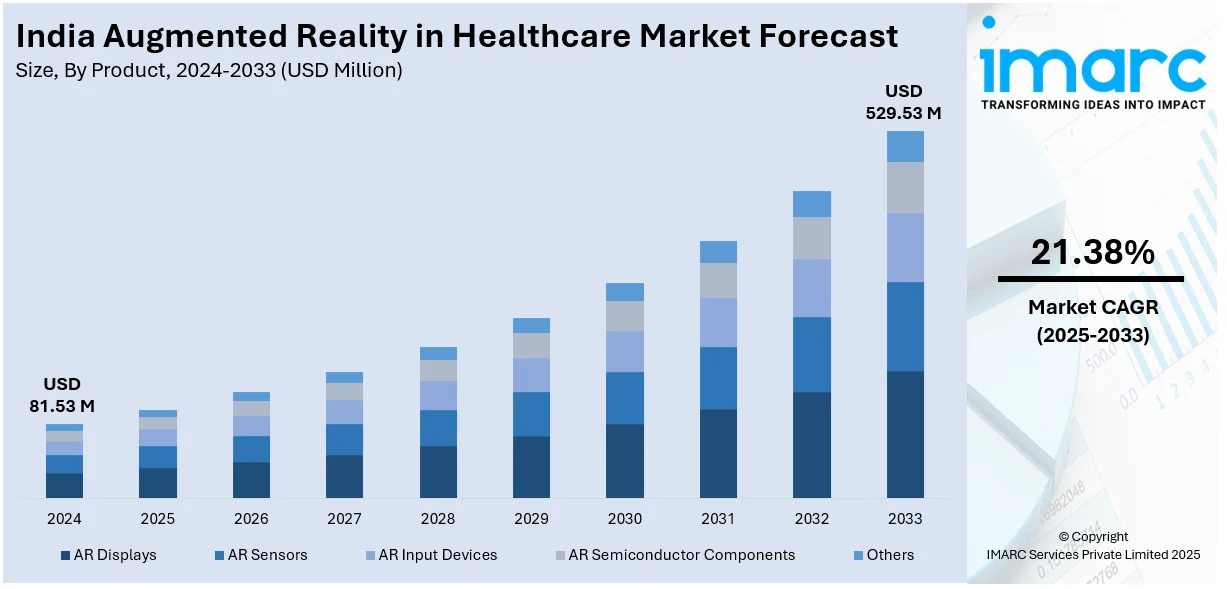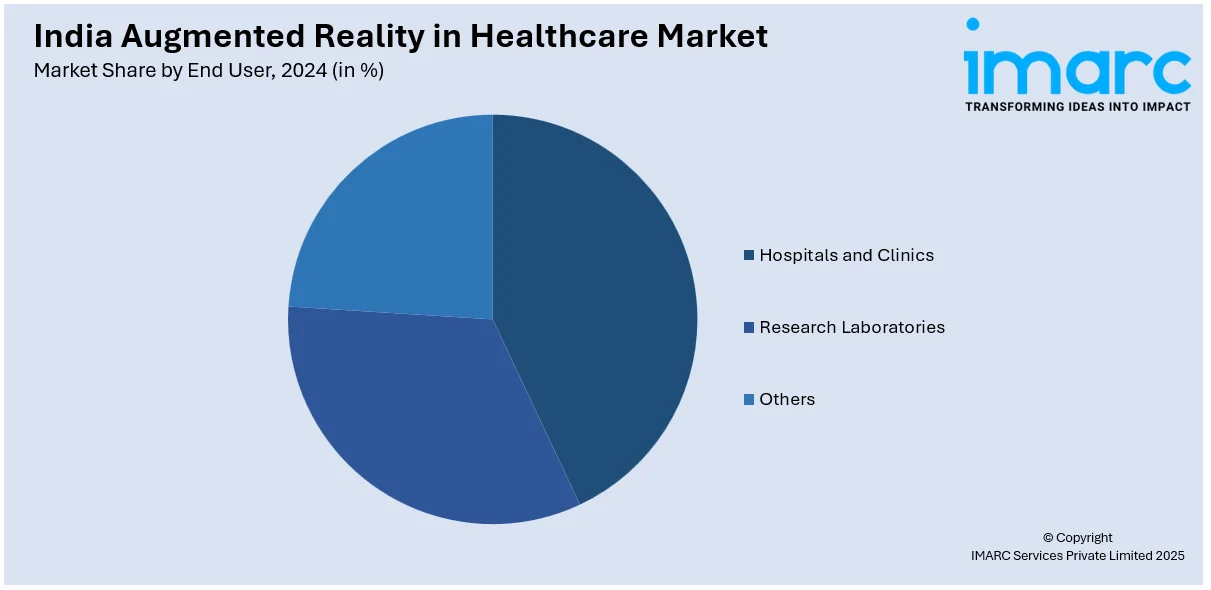
India Augmented Reality in Healthcare Market Size, Share, Trends and Forecast by Product, Technology, End User, and Region, 2025-2033
India Augmented Reality in Healthcare Market Overview:
The India augmented reality in healthcare market size reached USD 81.53 Million in 2024. Looking forward, IMARC Group expects the market to reach USD 529.53 Million by 2033, exhibiting a growth rate (CAGR) of 21.38% during 2025-2033. The India augmented reality in healthcare market share is expanding, driven by the rising incorporation of augmented reality into telemedicine platforms, enhancing access to remote places, along with the increasing adoption of modern technologies that allow medical students and professionals to visualize complex anatomical structures.
|
Report Attribute
|
Key Statistics
|
|---|---|
|
Base Year
|
2024 |
|
Forecast Years
|
2025-2033
|
|
Historical Years
|
2019-2024
|
| Market Size in 2024 | USD 81.53 Million |
| Market Forecast in 2033 | USD 529.53 Million |
| Market Growth Rate 2025-2033 | 21.38% |
India Augmented Reality in Healthcare Market Trends:
Increasing focus on patient care and timely diagnosis
The rising emphasis on patient care and prompt diagnosis is offering a favorable India augmented reality in healthcare market outlook. Augmented reality tools help healthcare providers to visualize complex anatomical structures in 3D, enabling better diagnosis and surgical planning. By offering real-time data visualization during procedures, augmented reality assists surgeons in performing minimally invasive (MI) surgeries with improved precision. This refines patient outcomes and reduces recovery times. In diagnostic procedures, augmented reality-based imaging systems give detailed insights, helping doctors detect conditions like tumors, fractures, or organ damage at an earlier stage. Additionally, augmented reality applications are being integrated into telemedicine platforms, allowing specialists to guide medical staff remotely using interactive visuals, improving access to quality care in remote areas. Apart from this, government institutions are working to develop modern solutions that assist in offering a better quality of life to patients, thereby fueling the India augmented reality in healthcare market growth. In March 2024, AIIMS Delhi introduced multiple initiatives designed to improve the skills of neurosurgeons, raise standards in healthcare practices, and enhance patient outcomes as well as the availability of services. A workshop was also conducted in which the Neurology Department employed several of UpSurgeOn's hyper-realistic surgical simulation models that featured augmented reality applications merging physical and digital elements.

To get more information on this market, Request Sample
Increasing utilization in medical training and education
Educational institutions and healthcare providers are adopting augmented reality tools to enhance learning experiences. Augmented reality technology allows medical students and professionals to visualize complex anatomical structures, surgical procedures, and treatment techniques in an interactive 3D environment. This immersive approach helps learners understand body systems, organ functions, and disease progression with greater clarity compared to traditional textbooks or 2D visuals. Augmented reality-oriented simulations also enable students to practice surgical processes, improving their precision and confidence without risking patient safety. Hospitals are also utilizing augmented reality devices to educate their staff on new medical equipment, ensuring healthcare workers are well-prepared to handle advanced technologies. By refining knowledge retention and skill development, augmented reality in medical education is contributing to better-trained healthcare professionals, ultimately enhancing patient care. Education centers are further focusing on inculcating augmented reality courses to educate in an immersive way. In March 2024, IIT Madras Pravartak Technologies Foundation teamed up with VyVoxel, the prominent technology firm, to provide a course on augmented reality/virtual reality programming, enabling students to pursue a career in this sector. The course included fundamental concepts of 3D modeling, along with its uses in training, manufacturing, and field services, and insights into applications across diverse sectors, such as healthcare, retail, architecture, and logistics.
India Augmented Reality in Healthcare Market Segmentation:
IMARC Group provides an analysis of the key trends in each segment of the market, along with forecasts at the regional level for 2025-2033. Our report has categorized the market based on product, technology, and end user.
Product Insights:
- AR Displays
- AR Sensors
- AR Input Devices
- AR Semiconductor Components
- Others
The report has provided a detailed breakup and analysis of the market based on the products. This includes AR displays, AR sensors, AR input devices, AR semiconductor components, and others.
Technology Insights:
- Head Mounted Devices
- Handheld Devices
A detailed breakup and analysis of the market based on the technologies have also been provided in the report. This includes head mounted devices and handheld devices.
End User Insights:

- Hospitals and Clinics
- Research Laboratories
- Others
The report has provided a detailed breakup and analysis of the market based on the end users. This includes hospitals and clinics, research laboratories, and others.
Regional Insights:
- North India
- South India
- East India
- West India
The report has also provided a comprehensive analysis of all the major regional markets, which include North India, South India, East India, and West India.
Competitive Landscape:
The market research report has also provided a comprehensive analysis of the competitive landscape. Competitive analysis such as market structure, key player positioning, top winning strategies, competitive dashboard, and company evaluation quadrant has been covered in the report. Also, detailed profiles of all major companies have been provided.
India Augmented Reality in Healthcare Market News:
- In January 2025, Resolve360 launched India's inaugural artificial intelligence (AI) and augmented reality application for active physiotherapy in India. The patented platform, scheduled for public launch by mid-February, sought to enhance physiotherapy services and boost patient results through advanced technology.
- In November 2024, IIT Delhi introduced a six-month Executive Programme in virtual and augmented reality. The curriculum comprised 216 total hours of instruction. Individuals aiming to refine their skills and incorporate augmented reality or virtual reality into their fields, like healthcare, simulations, storytelling, and graphics, could apply.
India Augmented Reality in Healthcare Market Report Coverage:
| Report Features | Details |
|---|---|
| Base Year of the Analysis | 2024 |
| Historical Period | 2019-2024 |
| Forecast Period | 2025-2033 |
| Units | Million USD |
| Scope of the Report | Exploration of Historical Trends and Market Outlook, Industry Catalysts and Challenges, Segment-Wise Historical and Future Market Assessment:
|
| Products Covered | AR Displays, AR Sensors, AR Input Devices, AR Semiconductor Components, Others |
| Technologies Covered | Head Mounted Devices, Handheld Devices |
| End Users Covered | Hospitals and Clinics, Research Laboratories, Others |
| Regions Covered | North India, South India, East India, West India |
| Customization Scope | 10% Free Customization |
| Post-Sale Analyst Support | 10-12 Weeks |
| Delivery Format | PDF and Excel through Email (We can also provide the editable version of the report in PPT/Word format on special request) |
Key Benefits for Stakeholders:
- IMARC’s industry report offers a comprehensive quantitative analysis of various market segments, historical and current market trends, market forecasts, and dynamics of the India augmented reality in healthcare market from 2019-2033.
- The research report provides the latest information on the market drivers, challenges, and opportunities in the India augmented reality in healthcare market.
- Porter's five forces analysis assist stakeholders in assessing the impact of new entrants, competitive rivalry, supplier power, buyer power, and the threat of substitution. It helps stakeholders to analyze the level of competition within the India augmented reality in healthcare industry and its attractiveness.
- Competitive landscape allows stakeholders to understand their competitive environment and provides an insight into the current positions of key players in the market.
Key Questions Answered in This Report
The augmented reality in healthcare market in India was valued at USD 81.53 Million in 2024.
The India augmented reality in healthcare market is projected to exhibit a CAGR of 21.38% during 2025-2033, reaching a value of USD 529.53 Million by 2033.
Key drivers include rising adoption of advanced medical technologies, increasing demand for remote training and surgical simulation, and growing use of AR in patient education. Supportive digital infrastructure and expanding healthcare investments further accelerate the integration of AR in India's medical sector.
Need more help?
- Speak to our experienced analysts for insights on the current market scenarios.
- Include additional segments and countries to customize the report as per your requirement.
- Gain an unparalleled competitive advantage in your domain by understanding how to utilize the report and positively impacting your operations and revenue.
- For further assistance, please connect with our analysts.
 Request Customization
Request Customization
 Speak to an Analyst
Speak to an Analyst
 Request Brochure
Request Brochure
 Inquire Before Buying
Inquire Before Buying




.webp)




.webp)












